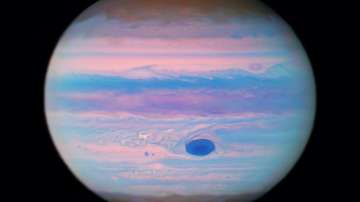NASA's Hubble Space Telescope shared stunning images of Jupiter leaving space enthusiasts mesmerised. The ultraviolet-observing capabilities of the telescope have allowed astronomers to study the short, high-energy wavelengths of light that we humans can not see with our naked eyes.
According to the NASA press release, "The image was taken when the planet and the Sun are on opposite sides of the sky providing a unique perspective of the gas giant including its most recognisable feature, the 'Great Red Spot'.
Sharing the image on social media platform it wrote, "Just in time for Jupiter reaching opposition, this Hubble image shows a unique view of the planet in ultraviolet light! Look up tonight to find Jupiter – it appears large and bright, because its position is directly opposite the Sun in the sky."
In another post, it wrote, "The data used to create this ultraviolet image is part of a Hubble proposal that looked at Jupiter’s stealthy superstorm system. The researchers plan to map deep water clouds using the Hubble data to define 3D cloud structures in Jupiter’s atmosphere."
Earlier, NASA's Lucy spacecraft on Wednesday (November 1) encountered the first of 10 asteroids on its long journey to Jupiter. The spacecraft swooped past the pint-sized Dinkinesh, about 300 million miles (480 million kilometers) away in the main asteroid belt beyond Mars. It was “a quick hello,” according to NASA, with the spacecraft zooming by at 10,000 mph (16,000 kph).
Lucy came within 270 miles (435 kilometers) of Dinkinesh, testing its instruments in a dry run for the bigger and more alluring asteroids ahead. Dinkinesh is just a half-mile (1 kilometer) across, quite possibly the smallest of the space rocks on Lucy's tour.
ALSO READ | NASA's Lucy spacecraft flies by pint-sized Dinkinesh, heads towards Jupiter
ALSO READ | Americans witness 'Ring of fire' solar eclipse, NASA shares video | WATCH
